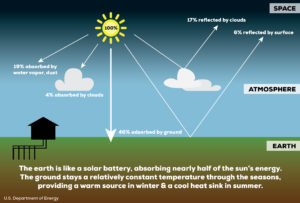Geothermal Heating Systems: How Do They Work?
-
Category
Innovation -
Posted By
Eric Broemel -
Posted On
May 09, 2017
Schmidt Associates has received an increasing number of inquiries about geothermal heating systems. We are also designing geothermal systems for a variety of projects. This blogs explains that technology.
A geothermal ground source heat pump (GSHP) is an electrically powered system that taps the stored energy of the greatest solar collector in existence: the earth. GSHP systems use the earth’s relatively constant temperature to provide heating, cooling, and hot water for homes and commercial buildings.

The heat pump system uses solar energy stored in the earth’s crust. Energy is transferred to and from the earth’s surface by solar radiation, wind, and rainfall. At depths greater than 30’, the earth’s temperature remains constant, and is comparable to annual average air temperature.
Between the surface and a depth of 8’ (the maximum depth to install a GSHP horizontal loop of pipes to collect and disperse heat) the ground temperature will swing above and below the annual average air temperature, depending on the geographic location, soil type, and moisture levels. Because of its own insulation, soil temperature is more moderate year round than outside air.
Look for our future blog to learn about four types of geothermal systems.






